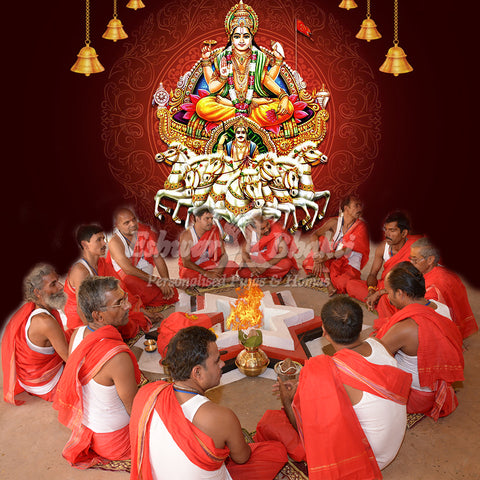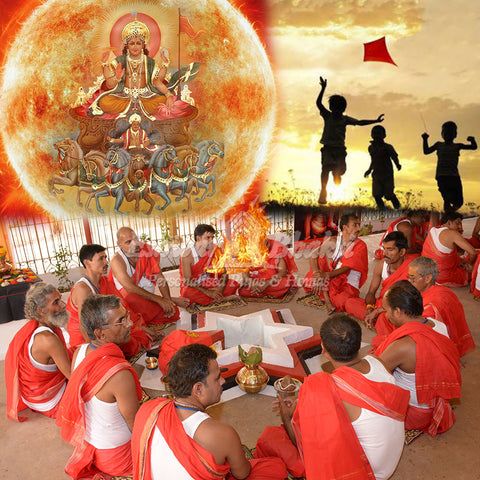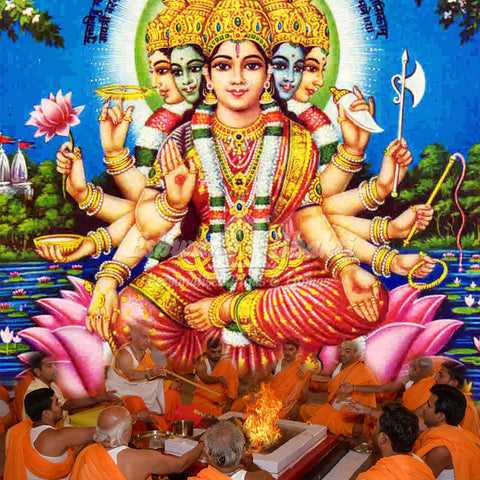Makar Sankranti
 Makar Sankranti is also known as Maghi, is an ancient Indian festival that has been observed according to solar cycles, while most festivals are set according to the lunar cycle of the Hindu calendar. Hindu devotees dedicate this festival to the God Sun (Surya), as the Sun begins to move towards the North from the southern hemisphere. According to Hindu scriptures, Uttarayan is considered to be a symbol of positivity and prosperity. This auspicious festival is observed each year in the lunar month of Magha which corresponds with the month of January as per the English calendar.
Makar Sankranti is also known as Maghi, is an ancient Indian festival that has been observed according to solar cycles, while most festivals are set according to the lunar cycle of the Hindu calendar. Hindu devotees dedicate this festival to the God Sun (Surya), as the Sun begins to move towards the North from the southern hemisphere. According to Hindu scriptures, Uttarayan is considered to be a symbol of positivity and prosperity. This auspicious festival is observed each year in the lunar month of Magha which corresponds with the month of January as per the English calendar.
Indian astrologers describe Makar Sankranti as a celestial event due to the Sun's transit into Makara Rashi (Capricorn), and the end of the winter solstice as well as starting of bright longer days. According to ancient scholars, the celebration of this auspicious day started around 300 AD in the Gangetic plains of India.
As per the teachings of Hindu sacred books, Makar Sankranti is considered an important day for spiritual practices. Devotees take a dip in holy rivers, like Ganga, Yamuna, Godavari, Krishna, Kaveri, and Sarayu. The bathing is believed to result in the absolution of all accumulated sins. They also offer water and pray to the Sun God and express gratitude for successes and prosperity. After every twelve years, the Hindus observe Makar Sankranti with one of the world's largest mass pilgrimages known as Kumbha Mela, with an estimated 100 million people attending the grand festival. On this holy day, they worship Lord Sun after taking bath at the Prayaga confluence of three rivers: Ganga, Yamuna, and Saraswathi.
As a traditional practice, Hindus of India and Nepal prepare sweets particularly from sesame (til) and jaggery (gud/ gur). All members of a family celebrate this festival together, visiting the houses of a near and dear one, by flying kites as well as dancing and singing around bonfires.
Indians celebrate Makar Sankranti by different names: Makara Sankranti is an important Hindu festival which is celebrated differently in various cultures. People living in different parts of India celebrate this colorful festival with different names, such as:
Maghi (preceded by Lohri) in Punjab - Punjabis celebrates this grand festival by bathing in a river in the early hours of Magh. Hindus light lamps with sesame oil as a sign of prosperity. They conduct a major fair in all Gurudwaras and distribute food to people from all religions. They sing and dance bhangra.
Delhi and Haryana - Most of the families prepare churma, halwa, puri, and kheer on this day. As an age-old tradition, brother of every married woman visits her home with a special gift, some warm clothes for his sister and other members of her family.
Gujarat, Rajasthan, and Madhya Pradesh - These states celebrate this auspicious festival by flying colorful kites. On this occasion, the skies of these regions are filled with kites, and youngsters engage in contests trying to cut each other's strings. People like to cook or buy special delicacies and sweets like pheeni (with sweet milk), til-paati, gajak, kheer, ghevar, pakodi, puwa, and til-laddoo on this occasion.
Uttar Pradesh and Bihar – Here the festival is known as Khichdi. On this holy day, people of these states donate Urad, rice, gold, woolen clothes, blankets, etc to the needy.
Odisha, Karnataka, Maharashtra – People of these states celebrate this auspicious festival with worship to God Sun while taking a holy bath before sunrise. Especially, the women of this region observe a ritual in which they donate cotton, oil, and sweets to other married women on their first Sankrant.
Tamil Nadu and other parts of South India - They celebrate this grand festival with another name called Pongal for four days.
Significance: Makar Sankranti is a popular pan-Indian solar festival. However, the significance and the sentiment attached to the festival vary depending on tradition and legends associated with it.
According to Vedic beliefs, God Sun begins its northward journey or Uttarayan journey (northern hemisphere), known as Devayana (the day of the devatas) from Dakshinayan which is called Pitriyan (the night of the devatas) on this auspicious day of Makar Sankranti. On this day, the Sun enters the zodiac sign of Capricorn (Makar) which marks the beginning of auspicious activities and the end of difficult winter months. Therefore, Makar Sankranti marks the beginning of an auspicious phase, and a lot of auspicious events like marriage, new business, and philanthropic activities are done during this period.
Legends of Makar Sankranti: Hindu texts describes that on this day the Sun God visit the house of his son, Saturn who is the ruler of the Makar Rashi. The father-son duo does not share a good relation. However, it is the responsibility of Lord Shani to take good care of his father. Hence, people celebrate this day with all family members which signify the importance of responsibilities.
According to another legend, Sankranti is deemed a deity. On this auspicious day, Goddess Sankranti killed a devil named Sankarasur. Thus, people started celebrating this day as the end of negativity and evil in life and the beginning of an era of righteous living.
According to the epic of Mahabharata (3102 BC), people in that era used to consider Makar Sankranti as an auspicious day. A plot from Mahabharat explains that the great warrior Pitamah Bhishma fell to the arrows of his grandson Arjuna on the Kurukshetra battlefield. After lying on the bed of arrows for almost a month, he chose the day of Makar Sankranti to leave his mortal body, so that he can attain salvation. That is why Hindus believe that those who die on this day will attain Moksha or salvation.
Summary: Makar Sankranti is one of the few ancient Indian festivals that has been observed according to the solar cycle of Hindu Pachanga. People from different regions largely celebrate this grand festival on the same date but with different names. It is observed with social festivities such as colorful decorations, kite flying, donation of food, clothes and other items to the needy. Vedic scriptures explain that it is one of the most auspicious days to organize all types of activities for a fruitful beginning.







